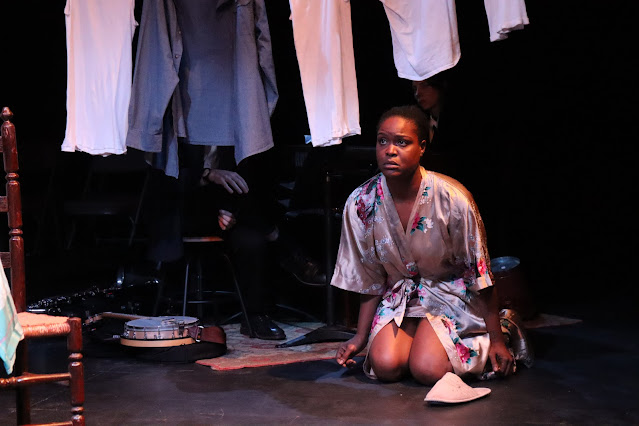PackRat
Written and directed by Renee Philippi
161A Chrystie St., Manhattan, NYC
January 31-February 14, 2020
 |
| L-R: Alanna Strong (Kitt); Maggie Gayford (Kip); Carlo Adinolfi (Bud); and Kayla Prestel (Happy). Photo by Stefan Hagen |
The inciting incident in Renee Philippi's new puppet-forward play
PackRat is a fire. Ignited accidentally by a careless rancher, it forces the animals of the Valley to flee before its advancing flames.
PackRat cites
Watership Down as an inspiration, but in these opening minutes, it is hard to avoid also thinking not only of the animals in
Bambi desperately running from a forest set ablaze by a human campfire but also of how much worse human avarice and disregard has made such events in the close to 80 years since the Disney film, as witnessed by the fires in California in recent years and, even more immediately, by the catastrophic, heart-sickening crisis in Australia. In PackRat, the animals of the Valley blame Bud, the eponymous packrat, for the fire because he collects human "treasures," which is not only unusual but against the laws of the Valley. As a result, the animals decide to banish Bud. The jackrabbit Firestone, leader of the Valley and sympathetic to Bud, has visions, like Fiver in
Watership Down, and he dreams of a place without humans, spurring him and the banished Bud to set off in search of this potential utopia.
 |
| L-R: Alanna Strong (Lizard) and Sabrina DeWeerdt (Tortoise). Photo by Stefan Hagen |
Firestone and Bud's journey sees them face various dangers, including from hawks and humans, and gain unexpected allies, as well as treating the audience to a little owl comedy. Throughout, offstage narration and dialogue by Vera Beren mix with onstage vocalizations by the puppeteers and an evocative score by Lewis Flinn. Bud's name betokens not only friendship but also the potential for growth or renewal, and, in the end, Bud must reckon with what kind of packrat he will be. The decisions that will shape that self-definition include his relationship to his home in the valley and the animals who live there and even how he relates to humans.
 |
| L-R: Alanna Strong & Maggie Gayford (Owls); Jenny Hann (Firestone); Carlo Adinolfi (Bud), Happy Kayla Prestel (Happy). Photo by Stefan Hagen |
PackRat features the work of a talented group of puppeteers (Carlo Adinolfi, Sabrina DeWeerdt, Maggie Gayford, Jenny Hann, Kayla Prestel, and Alanna Strong) who bring the characters to expressive life and strike a compelling balance between anthropomorphized and studiedly realistic movement. The primary packrat, rabbit, and squirrel puppets boast an appealingly textured look with an open center that suggests a rib cage, while in dream sequences, the puppets appear more like outlines or living line art. One sequence creates a sense of scale by using silhouette puppets, and the presentation of the humans as faceless beings with huge, disproportionate cowboy hats and appendages lends an appropriate sense of the animals' perspective. The main components of the cleverly constructed set are sculptural curves that suggest blades of grass and can be reconfigured to indicate varied locations and projections that most often give an abstract suggestions of place but also include some elegantly spare animation.
 |
| L-R: Kayla Prestel (Happy); Jenny Hann (Quick & Kitt); Carlo Adinolfi (Bud); Alanna Strong (Cowgirl), Sabrina DeWeerdt (Tortoise). Photo by Stefan Hagen |
A play must be doing something right when it can successfully invest a serving spoon with emotional resonance.
PackRat tells a straightforward but moving tale, wonderfully performed. If one can see a theatrical experience as another kind of human treasure, you will want to add some time spent with Bud, Firestone, and the other inhabitants of the Valley to your own collection.
-John R. Ziegler and Leah Richards







Comments
Post a Comment